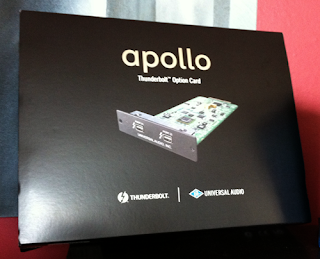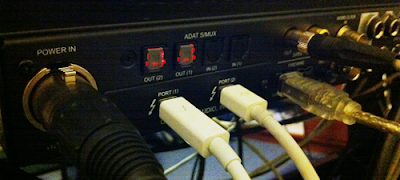 |
| A large box for a small card. That image of the card is pretty close to “actual size” |
Further to my recent review of the UAD Apollo, I finally received my Apollo Thunderbolt interface card today. (More on what Thunderbolt is on Intel’s site and on Apple’s site)
 |
| There’s a lot of chippage going on in this little card. |
That means I can now use the fancy little Thunderbolt port on my Mac Book Pro instead of the Firewire 800 port.
 |
| So much simpler – only three cables needed now. |
So what are the benefits?
Thunderbolt has blisteringly fast bandwidth compared to Firewire
That means there are virtually no bandwidth limitations on the number of Apollo-hosted UAD plugins you can use. This wasn’t too much of a problem with Firewire anyway – unless you wanted to share your Firewire port with, say, an external hard drive. Which you tend to do quite a bit when you’re recording/mixing music.
Thunderbolt gives way lower latency times than Firewire – I can now run Logic quite happily with a 32 sample buffer, (as long as my project isn’t too huge). It used to choke a bit before.
I’ve also noticed Logic feels a little snappier and more responsive when starting/stopping playback, and the songs load and close slightly faster – perhaps due to the UAD plugins loading and unloading faster. Perhaps it’s just my imagination – further testing will reveal whether this is the case.
I also haven’t taken the time to check out the higher sample rates yet.
Convenience
A cool thing about Thunderbolt is that it’s daisy-chainable (as is Firewire, by the way).
But what I particularly like about it is that I can plug my laptop into the Apollo’s new Thunderbolt port, and then there’s still a second Thunderbolt port on the card which I can then plug into my studio’s LCD monitor – just using my usual laptop DVI-VGA adaptor. Magic.
Even better – the two Firewire 800 ports on the back of the Apollo now become a Firewire hub, so one of the ports can now be plugged into my external Firewire hard drive – and it all goes through the Thunderbolt cable into my laptop.
So that little skinny little Thunderbolt cable is handling audio going to and from the Apollo, UAD plugin data going to and from the Apollo, video being sent to my studio LED monitor, and data to and from my external hard drive. That’s a lot of stuff going on.
For me, convenience is a big thing. I want a simple, tidy connection setup – especially as I use my laptop as my main studio computer and want to be able to come home and plug it into my studio setup with a minimum of fuss. As you can see, Thunderbolt does this really well.
Installation
This was easy – unplug the Apollo’s power, use the included allen key to take the little slot cover off the back of the Apollo (make sure to remove any static from yourself), then slide in the Thunderbolt card. Put the screws back in. Plug the power back in, connect Thunderbolt cable and turn it on. Took about 2 minutes.
It showed up in the computer exactly the same as before, but without the Firewire bandwidth meter and settings in the Apollo Control Panel.
Note that you will have to update your UAD software and the firmware in the Apollo before fitting the card if you haven’t already (I had). You also can’t connect to your computer with Firewire AND Thunderbolt at the same time. It doesn’t like it, apparently.
Downsides
Expense. It’s currently about $700NZ for the interface card – I think that’s still a little over-priced, but perhaps the price will drop as they produce more of them.
Thunderbolt cables are also a little expensive at the moment – $78NZ for a 2-metre cable.
Ouch. Still – not as bad as the first Firewire cable I ever bought – that was $300NZ!
Also – for those that didn’t go and check out the Thunderbolt links at the top – the cables are in part so expensive because they have circuitry in each of the connectors so they can combine (and then separate at the other end) the video and the data.
Conclusion
Most people will probably find that the Apollo is just fine with the existing Firewire 800 option.
Those who are pushing the limits of their setup all the time (like I am!), or want ultra-low latencies for tracking, or who prefer a simple and tidy studio cabling setup, would definitely benefit from this Thunderbolt card.
And as more and more Thunderbolt-compatible devices become available, the convenience of being able to daisy-chain all these devices together will be even more of a priority.
